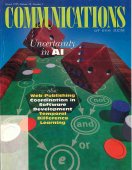The Internet is not TV: Web publishing
Don't turn the page. This is not yet-another article on how great the World-Wide Web is, and how fast it is growing. By now you must have read many of those, and surfed the Web a bit. But, the Internet is not television—are you ready to become a Web author? This article describes tools and considerations for publishing on them Web, and looks toward the future. Let's start with server platfroms.




